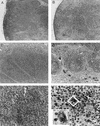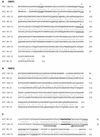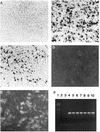Detection of a novel strain of porcine circovirus in pigs with postweaning multisystemic wasting syndrome
- PMID: 9705388
- PMCID: PMC105158
- DOI: 10.1128/JCM.36.9.2535-2541.1998
Detection of a novel strain of porcine circovirus in pigs with postweaning multisystemic wasting syndrome
Abstract
Swine infectious agents, especially viruses, are potential public health risks associated with the use of pig organs for xenotransplantation in humans. Therefore, there is a need for better characterization of swine viruses and for the development of diagnostic tests for their detection. We report here isolation of a novel strain of porcine circovirus (PCV) from pigs with postweaning multisystemic wasting syndrome (PMWS). Affected pigs exhibited severe interstitial pneumonia and lymphoid depletion. The complete nucleotide sequence (1,768 nucleotides) of the genome of the PCV isolate was determined and compared with the sequence of the PCV strain isolated from PK-15 cells. Sequence comparison revealed significant differences between the two PCV strains, with an overall DNA homology of 76%. Two major open reading frames (ORFs) were identified. ORF1 was more conserved between the two strains, with 83% nucleotide homology and 86% amino acid homology. ORF2 was more variable, with nucleotide homology of 67% and amino acid homology of 65%. PCR and in situ hybridization demonstrated abundant viral DNA in various organs of pigs with PMWS. In situ hybridization demonstrated that this strain of PCV targets multiple organs and infects macrophages, lymphocytes, endothelial cells, and epithelial cells.
Figures




Similar articles
-
Detection of porcine circovirus from lesions of a pig with wasting disease in Japan.J Vet Med Sci. 1999 Oct;61(10):1119-23. doi: 10.1292/jvms.61.1119. J Vet Med Sci. 1999. PMID: 10563289
-
Multiplex PCR for detection and typing of porcine circoviruses.J Clin Microbiol. 1999 Dec;37(12):3917-24. doi: 10.1128/JCM.37.12.3917-3924.1999. J Clin Microbiol. 1999. PMID: 10565907 Free PMC article.
-
Postweaning multisystemic wasting syndrome of pigs in Korea: prevalence, microscopic lesions and coexisting microorganisms.J Vet Med Sci. 2002 Jan;64(1):57-62. doi: 10.1292/jvms.64.57. J Vet Med Sci. 2002. PMID: 11853147
-
Postweaning multisystemic wasting syndrome (PMWS) in pigs with particular emphasis on the causative agent, the mode of transmission, the diagnostic tools and the control measures. A review.Vet Q. 2005 Sep;27(3):105-16. doi: 10.1080/01652176.2005.9695191. Vet Q. 2005. PMID: 16238110 Review.
-
Postweaning multisystemic wasting syndrome: a review of aetiology, diagnosis and pathology.Vet J. 2004 Jul;168(1):41-9. doi: 10.1016/j.tvjl.2003.09.018. Vet J. 2004. PMID: 15158207 Review.
Cited by
-
First molecular detection and complete sequence analysis of porcine circovirus type 3 (PCV3) in Peninsular Malaysia.PLoS One. 2020 Jul 24;15(7):e0235832. doi: 10.1371/journal.pone.0235832. eCollection 2020. PLoS One. 2020. PMID: 32706778 Free PMC article.
-
An ELISA based on a truncated soluble ORF2 protein for the detection of PCV2 antibodies in domestic pigs.Virol Sin. 2010 Jun;25(3):191-8. doi: 10.1007/s12250-010-3085-5. Epub 2010 Jun 6. Virol Sin. 2010. PMID: 20960293 Free PMC article.
-
Immunogenicity of empty capsids of porcine circovius type 2 produced in insect cells.Vet Res Commun. 2007 May;31(4):487-96. doi: 10.1007/s11259-007-3469-7. Vet Res Commun. 2007. PMID: 17225085
-
Genotype Shift of Malaysian Porcine Circovirus 2 (PCV2) from PCV2b to PCV2d within a Decade.Animals (Basel). 2022 Jul 21;12(14):1849. doi: 10.3390/ani12141849. Animals (Basel). 2022. PMID: 35883396 Free PMC article.
-
Concurrent infections are important for expression of porcine circovirus associated disease.Virus Res. 2012 Mar;164(1-2):20-32. doi: 10.1016/j.virusres.2011.09.014. Epub 2011 Sep 16. Virus Res. 2012. PMID: 21959087 Free PMC article. Review.
References
-
- Albina E. Epidemiology of porcine reproductive and respiratory syndrome (PRRS): an overview. Vet Microbiol. 1997;55:309–316. - PubMed
-
- Allan G M, McNeilly F, Cassidy J P, Reilly G A C, Adair B, Ellis W A, McNulty M S. Pathogenesis of porcine circovirus, experimental infections of colostrum deprived piglets and examination of pig fetal material. Vet Microbiol. 1995;44:49–64. - PubMed
-
- Allan G M, Phenix K V, Todd D, McNulty M S. Some biological and physico-chemical properties of Porcine Circovirus. J Vet Med B. 1994;41:17–26. - PubMed
-
- Boevink P, Chu P W G, Keese P. Sequence of Subterranean Clover Stunt Virus DNA: affinities with the Geminiviruses. Virology. 1995;207:354–361. - PubMed
-
- Botner A. Diagnosis of PRRS. Vet Microbiol. 1997;55:295–301. - PubMed
MeSH terms
Substances
LinkOut - more resources
Full Text Sources
Other Literature Sources

